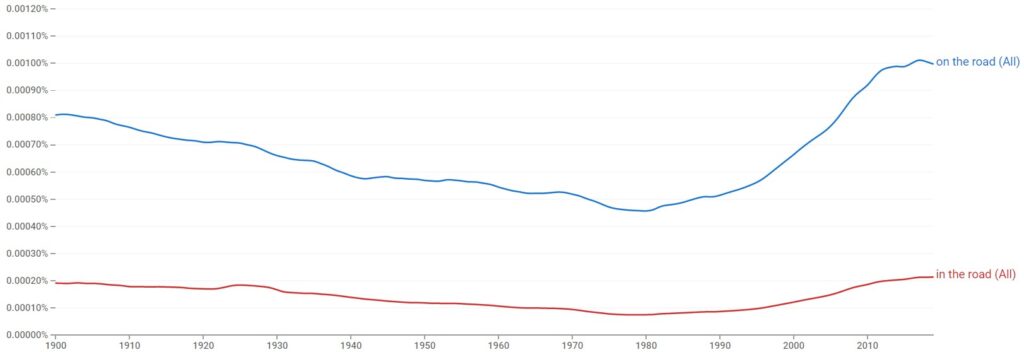The phrases “in the road” and “on the road” are both in use. Do they mean the same thing or are they used differently? When do we use them and why?
“On The Road” or “In The Road” – Which Is Correct?
When describing location, the phrase used is “on the road”, as opposed to “on the pavement” or “off the road”. “On the road” has the meaning of “travelling”. If an object is “in the road”, it conveys danger or presents a hazard to other road users.

The idea of obstruction conveyed by “in the road” is also used in a wider sense to describe anything which impedes, whether physical or abstract. The two forms are sometimes interchangeable, for instance, a vehicle parked “on the road”, if it impedes traffic, is also “in the road”.
On The Road
“On the road” refers to the location, literally, on the surface of the road. However, it is used to convey the action of “travelling” along a road or by road. The phrase “on the road to” is also used to describe the location of something with respect to a destination.
The expression “on the road” is often used to describe the travelling part of someone’s job, for instance, a truck driver spends a lot of time “on the road”. When giving direction, it is common to say something like “it is on the road to Oxford”.
Here are some examples of how to use “on the road” in a sentence:
- There was no time to prepare lunch, and so we set off with a plan to stop for something to eat on the road.
- They often saw ponies, badgers, and deer on the road to his mother’s house.
- If you drive directly west, you will pass the factory on the road to the next village.
- After two years without performing in any live concerts, the band were excited to be back on the road again.
- His business suffers from a lack of direction and the new management team seems to be on the road to nowhere.
- I love the freedom of driving where I want whenever I want, but life can get lonely on the road.
- He encountered many challenges on the road to fame and fortune.
In The Road
The phrase “in the road” doesn’t just convey location, but implies that there is some potential danger involved, for instance “the children were playing in the road”. It is often employed to warn other road users that there may be obstacles or hazards ahead, and to exercise caution.
“In the road” is employed, correctly, to describe hazards on the highway, but is also used in a wider application. Any obstruction to progress may be said to be “in the road”. For instance, “the commitment to preserve the original walls got in the road of the architect’s plans”.
Here are some examples of how to use “in the road” in a sentence:
- The hazardous waste fell from the truck and was now in the road of oncoming traffic.
- There are always some people who resist change at any cost and who will stand in the road of progress.
- I wanted to move the car closer to the house but there was a flock of sheep in the road.
- I shouted to my neighbour to warn her that her children were playing in the road.
- The view from the house down to the sea would be perfect if there were not so many electricity pylons in the road!
- The police acted quickly to remove the car as it was in the road of oncoming traffic.
- He had a clear view of the finishing line, and he could sense victory until a camera crew got in the road!
Which Is Used The Most?
According to the Google Ngram Viewer, the phrase “on the road” is used much more often than “in the road”.

This reflects the more frequent use of “on the road” to refer to location and the more limited use of “in the road” to refer to a hazard or obstacle.

Martin holds a Master’s degree in Finance and International Business. He has six years of experience in professional communication with clients, executives, and colleagues. Furthermore, he has teaching experience from Aarhus University. Martin has been featured as an expert in communication and teaching on Forbes and Shopify. Read more about Martin here.
